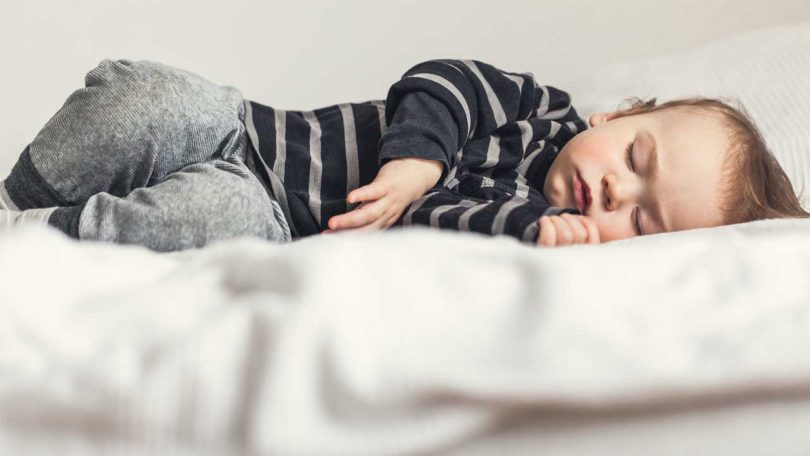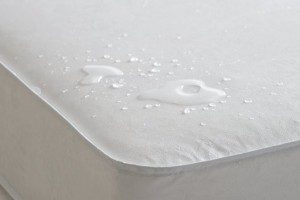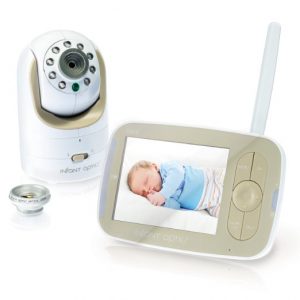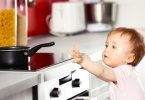Your baby will likely spend more time in his bedroom than anywhere else in the house, especially in the early months, so it’s important that it’s a safe and comfortable space. Find out everything you need to consider when you child proof your baby’s bedroom.
Creating a baby proof bedroom
Cribs
It’s sounds obvious, but if you want a baby proof bedroom, first and foremost the crib or cot should be safe. In the US drop-side cribs are now illegal following a series of deaths, but they are still available in the UK where the design is different and means that it would be impossible for incidents like those in the US to happen on a British-made bed. Check out the detail on crib safety standards.
Main types of crib:
Convertible:
Useful if you want a crib that grows with your child, through toddler hood and right up to their adult years. If you’re buying a bed for your last or only child this is the best value crib set up.
Standard:
You might want to choose a standard crib if you’re likely to have more babies, so don’t want to convert the crib right through to a full size bed.
Key considerations when buying a crib:
Sturdiness
Most babies will sleep in a crib or cot until the age of two or three years old, so it’s important that you buy something that is solid.
Slat size
Aim for slats that are two and three eighths of an inch wide or less to avoid trapping.
Avoid bumpers
Bumpers are the cushioned panels that wrap around the bottom of the crib, sitting just above the mattress. They’re now considered a SIDS risk because of the risk of baby’s airways becoming blocked during sleep and are best avoided.
Avoid blankets & soft toys
Keep soft toys and comforters out of the crib if possible to avoid suffocation. My youngest son was very attached to his blanket so I tied it firmly to a crib slat so that he could hold it safely without the risk of it becoming wrapped around his face or neck – but the safest thing is to have nothing in the crib except your baby.
Try a sleep bag instead of blankets. Sleep bags are designed to stop baby from slipping inside (and kicking off covers) so they can stay safe and snug all night. A winner in our house!
Sleeping position
The Foundation for the Study of Infant Deaths recommends that you always put baby to sleep on her back to avoid Sudden Infant Death Syndrome (SIDS). This is a fantastic resource if you have any concerns about SIDS.
Should you buy second hand?
Second hand cribs can be OK as long they’re less than 10 years old. Older cribs may have been recalled, or have general wear and tear issues. In any case, your crib should be free of splinters, flaking paint and loose/missing screws in order to be safe for your baby to sleep in. Choose second hand beds very carefully – used cribs can be unsafe for many reasons, so if it doesn’t comply with safety regulations or isn’t in good condition it’s probably best avoided.
Mattresses
Who knew there was so much to think about! Lumbar support, wipe-ability, chemicals, durability, sprung, memory foam… it’s a minefield!
Key considerations when buying a mattress
Your crib mattress will likely need to last three years or more, so durability is important. And so is the age of a mattress. A link has been established between SIDS (Sudden Infant Death Syndrome) and pre-used mattresses which is down to the bacteria, dust mites and mould that they can harbour. For that reason I would advise buying mattresses for a baby’s crib brand new – the Foundation for the Study of Infant Deaths even recommends buying a new one for each of your own children.
The choice between memory foam, pocket sprung or foam is really one of budget and personal preference. All options are available free of harmful chemicals in order to be deemed ‘safe’.
Parents LOVE this Greenguard Gold certified, waterproof mattress. Check the reviews here.
Safety 1st Heavenly Dreams Crib Mattress
Lightweight, durable and reassuringly phthalates & lead-free. It has a waterproof vinyl cover & firm support.
Bed rail
Baby’s move from her crib or cot to a ‘big girl bed’ can be really daunting for a parent. I camped out for the first couple of nights amidst soft cushions and blankets, waiting for the inevitable thud. Then I discovered bed rails! A total game changer.
Bed rails essentially attach to the side of the bed and prevent your toddler from tumbling onto the floor. There is a big enough gap for your toddler to get out of the bed but there’s no risk of falling out. Perfect! But which bed rail is best for you?
What kind of bed rail?
Swing down bed rail
Swing down bed rails are great: they’re easy to use, and because the rail fits under the sheets and swings down out of the way making the bed is a breeze.
Fixed bed rail
Fixed bed rails work in the same way as swing down rails, but as the name suggests they are fixed. They work just as well but make access to the bed a bit of pain and they don’t tuck away out of sight.
Bumper bed rail
There are two kinds of bumper bed rails and both are very effective.
Inflatable bed rails:
Super easy to use and very portable. They provide a long sausage-like barrier to keep kids from tumbling out of bed – just blow it up, tuck it under the sheet and you’re away! Perfect for throwing in your suitcase and taking on vacation.
Foam bed rails:
Again, a breeze to use and do the job well. The only difference is that it’s made of rigid foam rather than inflatable, and while it doesn’t pack down as small as the inflatable ones they’re still pretty easy to throw in the car to take to the grandparents’ house.
The alternative? If your toddler’s bed is close to the floor and they’re not too active in bed then cushions will do the trick!
Baby monitors
Baby monitors are invaluable if your main living area is out of earshot of your nursery. Even if it isn’t, having a monitor means you can make the most of your child-free time by relaxing rather than running into the nursery every two minutes.
Baby monitors are pretty sophisticated these days, and the type you decide on will be determined by a few different factors. Here are few things to consider:
- The distance between your living area and nursery
- Whether you want to see your baby as well as hear him
- Whether you want to monitor room temperature
- Budget
The most basic baby monitors will give you an audible and visual record of sound on a sound indicator. If you go for something top of the range you will find monitors with screens, interchangeable lenses, extra cameras, thermometers, alarms… ask it nicely and it might change your baby’s diaper too 🙂
Just remember to keep any baby monitors at least three feet away from the crib to avoid the risk of your baby getting tangled in the chord.
Infant Optics DXR-8 Video Baby Monitor with Interchangeable Optical Lens
Fully customizable full colour monitor with interchangeable lenses and long battery life.
Hopefully you now feel equipped to create a baby proof bedroom! Check out our other baby proofing guides for the kitchen, bathroom and fireplace.









